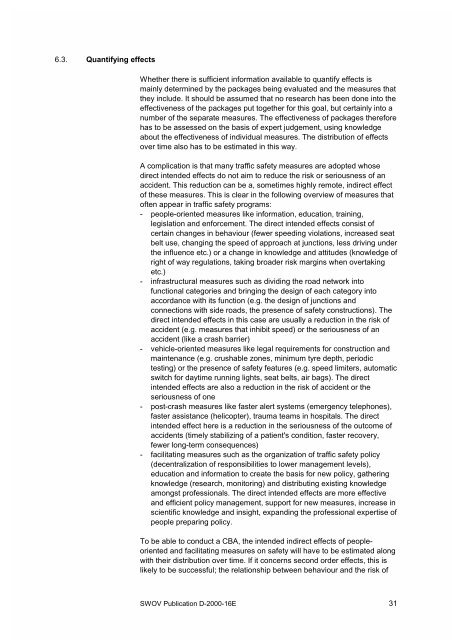Economic evaluation of road safety measures - Swov
Economic evaluation of road safety measures - Swov
Economic evaluation of road safety measures - Swov
Create successful ePaper yourself
Turn your PDF publications into a flip-book with our unique Google optimized e-Paper software.
6.3. Quantifying effects<br />
Whether there is sufficient information available to quantify effects is<br />
mainly determined by the packages being evaluated and the <strong>measures</strong> that<br />
they include. It should be assumed that no research has been done into the<br />
effectiveness <strong>of</strong> the packages put together for this goal, but certainly into a<br />
number <strong>of</strong> the separate <strong>measures</strong>. The effectiveness <strong>of</strong> packages therefore<br />
has to be assessed on the basis <strong>of</strong> expert judgement, using knowledge<br />
about the effectiveness <strong>of</strong> individual <strong>measures</strong>. The distribution <strong>of</strong> effects<br />
over time also has to be estimated in this way.<br />
A complication is that many traffic <strong>safety</strong> <strong>measures</strong> are adopted whose<br />
direct intended effects do not aim to reduce the risk or seriousness <strong>of</strong> an<br />
accident. This reduction can be a, sometimes highly remote, indirect effect<br />
<strong>of</strong> these <strong>measures</strong>. This is clear in the following overview <strong>of</strong> <strong>measures</strong> that<br />
<strong>of</strong>ten appear in traffic <strong>safety</strong> programs:<br />
- people-oriented <strong>measures</strong> like information, education, training,<br />
legislation and enforcement. The direct intended effects consist <strong>of</strong><br />
certain changes in behaviour (fewer speeding violations, increased seat<br />
belt use, changing the speed <strong>of</strong> approach at junctions, less driving under<br />
the influence etc.) or a change in knowledge and attitudes (knowledge <strong>of</strong><br />
right <strong>of</strong> way regulations, taking b<strong>road</strong>er risk margins when overtaking<br />
etc.)<br />
- infrastructural <strong>measures</strong> such as dividing the <strong>road</strong> network into<br />
functional categories and bringing the design <strong>of</strong> each category into<br />
accordance with its function (e.g. the design <strong>of</strong> junctions and<br />
connections with side <strong>road</strong>s, the presence <strong>of</strong> <strong>safety</strong> constructions). The<br />
direct intended effects in this case are usually a reduction in the risk <strong>of</strong><br />
accident (e.g. <strong>measures</strong> that inhibit speed) or the seriousness <strong>of</strong> an<br />
accident (like a crash barrier)<br />
- vehicle-oriented <strong>measures</strong> like legal requirements for construction and<br />
maintenance (e.g. crushable zones, minimum tyre depth, periodic<br />
testing) or the presence <strong>of</strong> <strong>safety</strong> features (e.g. speed limiters, automatic<br />
switch for daytime running lights, seat belts, air bags). The direct<br />
intended effects are also a reduction in the risk <strong>of</strong> accident or the<br />
seriousness <strong>of</strong> one<br />
- post-crash <strong>measures</strong> like faster alert systems (emergency telephones),<br />
faster assistance (helicopter), trauma teams in hospitals. The direct<br />
intended effect here is a reduction in the seriousness <strong>of</strong> the outcome <strong>of</strong><br />
accidents (timely stabilizing <strong>of</strong> a patient's condition, faster recovery,<br />
fewer long-term consequences)<br />
- facilitating <strong>measures</strong> such as the organization <strong>of</strong> traffic <strong>safety</strong> policy<br />
(decentralization <strong>of</strong> responsibilities to lower management levels),<br />
education and information to create the basis for new policy, gathering<br />
knowledge (research, monitoring) and distributing existing knowledge<br />
amongst pr<strong>of</strong>essionals. The direct intended effects are more effective<br />
and efficient policy management, support for new <strong>measures</strong>, increase in<br />
scientific knowledge and insight, expanding the pr<strong>of</strong>essional expertise <strong>of</strong><br />
people preparing policy.<br />
To be able to conduct a CBA, the intended indirect effects <strong>of</strong> peopleoriented<br />
and facilitating <strong>measures</strong> on <strong>safety</strong> will have to be estimated along<br />
with their distribution over time. If it concerns second order effects, this is<br />
likely to be successful; the relationship between behaviour and the risk <strong>of</strong><br />
SWOV Publication D-2000-16E 31
















